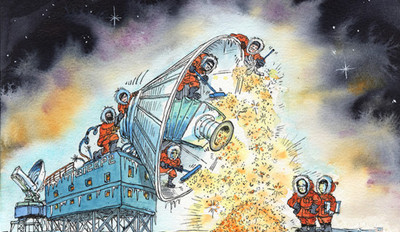(单词翻译:单击)
中英文本
Astrophysics
天体物理
Dust to dust
尘归尘,土归土
A dramatic recent “discovery” in physics is looking rather dodgy
近期,物理学中的一项戏剧性发现看上出非常模糊
IN MARCH Chao-Lin Kuo, an astrophysicist at Stanford University, filmed himself knocking on the door of his colleague Andrei Linde. In the 1980s Dr Linde was one of several cosmologists who developed the theory of cosmic inflation, which holds that, in the first instants of its existence, the universe underwent a brief period of faster-than-light expansion.
三月,斯坦福大学天体物理学家郭兆林拍下了自己造访同事Andrei Linde的一幕。上世纪80年代,Linden博士是少有的几位发展了宇宙膨胀论的宇宙学家。宇宙膨胀论认为,在其出现的那一瞬间,宇宙经历了一段超光速膨胀。
Because inflation neatly cleaves several knotty problems in cosmology, many astrophysicists (though not all) subscribe to the theory. But direct, unambiguous evidence for it has been lacking. That was why Dr Kuo was visiting Dr Linde—to tell him that, thanks to the work of a telescope in Antarctica called BICEP-2, such evidence had now been found. After digesting the news, an emotional Dr Linde broke open a bottle of champagne to celebrate. The video has been viewed almost 3m times.
因为膨胀论能完整解释宇宙学中的一些难题,许多天体物理学家都倾向于该理论。但是膨胀论仍缺乏直接、清晰的证据。这正是郭博士拜访Linde博士的原因—在南极洲的BICEP-2天文望远镜发现了这种证据。收到消息后,Linde博士开了一瓶香槟来庆祝。这段视频已经被浏览了将近300万次。

It now seems that Dr Kuo might have to make a new video, informing Dr Linde that he has wasted a bottle of bubbly. A paper just released by the team behind Planck, a European space telescope, casts serious doubt on the BICEP-2 result. What looked like a clear window back into the earliest moments of the universe might simply have been a faint glow from the diaphanous clouds of dust that exist between the stars.
现在好像郭博士不得不再做一个视频,告诉Linde博士他浪费了一瓶香槟。新近有文献报道称,欧洲的普朗克天文望远镜拍到了对BICEP研究构成重大质疑的结果。回溯到宇宙最初时间,看上去似乎是清晰的窗户的图像可能仅仅是恒星间的透明灰云折射的淡淡光芒。
The BICEP-2 team, led by John Kovac of Harvard University, had been studying the cosmic microwave background radiation (CMB)—a weak bath of radiation, left over from the Big Bang, that suffuses the universe. They were looking for evidence of primordial gravitational waves. These are ripples in the fabric of space, created, if the theory of inflation is correct, as the early universe was undergoing its post-creation growth spurt.
由哈佛大学John Kovac领导的BICEP-2小组长期研究宇宙微波背景辐射,即一种由大爆炸产生的微弱辐射,弥漫在宇宙中。他们在找寻原始引力波的证据。如果膨胀论是正确的的话,那么这种由宇宙在初创后迸发过程中产生的波会存在于空间架构中。
A dusty trail
布满尘埃的小径
Such waves should have left a distinctive, polarised mark imprinted upon the CMB. And, in a press conference on March 17th, that is exactly what the BICEP-2 team claimed to have found. It was the biggest news in physics since the discovery, in 2012, of the Higgs boson, and it was widely covered (including in The Economist). Not only would the BICEP result have confirmed the theory of inflation, but studying the gravitational waves it purported to have found would have given cosmologists a way to look back to the very earliest moments of the universe.
这种波应该在宇宙微波辐射背景上留下了一个独特的、极化的记号。并且,在3月17日的新闻发布会上,BICEP-2小组宣布发现的,正是这个记号。这是从2012年希格斯玻色子发现以来,物理学界最大的新闻,并广为传播(包括《经济学人》)。BICEP的结果不仅确认了膨胀论这么简单,研究他们宣称所发现的引力波,将为宇宙学家提供一条回溯宇宙最开始的时刻的方法。
But gravitational waves are not the only things that BICEP-2 might have picked up. The Milky Way is filled with thin clouds of interstellar dust which, under the influence of the galaxy's magnetic field, scatter and polarise starlight. The BICEP team were confident that the contamination from the dust was small enough not to affect their detection of gravitational waves. But the behaviour of the dust is poorly understood, says Chris Lintott, an astronomer at Oxford University, and not everyone was convinced.
但是引力波并不是BICEP-2发现的唯一一件事情。银河中遍布的星级尘埃,在星系磁场的作用下,散射或极化星光。BICEP小组相信,灰尘的污染非常小,不足以影响其对引力波的测定。但是牛津大学的天文学家Chris Lintott称,对灰尘行迹我们理解不足,而且无法令所有人信服。
The Planck results suggest that they were right to be sceptical. The European telescope has just unveiled a map of dust density across the entire sky. It suggests that, contrary to the BICEP team's hopes, the signal from the dust is so strong that the telescope might well have seen no primordial gravity waves at all.
Planck小组的结果说明,怀疑论者是正确的。欧洲天文望远镜最近提出了一份整个天空中的灰尘的密度分布图。分布图显示,同BICEP小组的假定相反,灰尘发出的信号很强,天文望远镜甚至无法检测到任何的原始引力波。
That, at least, is the most likely interpretation, but it is not the only one. The Planck team are careful to stop short of saying that their results are fatal to BICEP's claims, pointing out that applying their data to the BICEP results involves considerable “statistical and systematic uncertainties”. There are, in other words, a couple of glimmers of hope that signs of inflation have actually been seen. One is that the precise behaviour of the dust is still mysterious, which means the mathematical transformations used to apply Planck's data to BICEP's results may turn out to be incorrect. And even if those maths are sound, statistics may ride to the rescue—for if the amount of radiation from the dust is at the lowest end of Planck's estimates, a small gravitational-wave signal may survive.
至少这是最有可能的解释。但却不是唯一的。普朗克小组谨慎地不曾宣称他们的结果对BICEP小组的声明有颠覆效果,而是指出,将他们所获得的数据应用于BICEP的结论中会产生可观的“统计学和系统上的不确定性”。换句话说,有些闪烁有望作为膨胀论确实存在的证据。一方面,灰尘行迹的精确表述依然是个谜,也就是说,将普朗克小组的数据转换为BICEP结果的数学过程可能是错误的。而且即使这些数学转换可靠,数据也可能出现问题。因为如果灰尘的辐射数量处在普朗克小组估计的最低端,可能会有一点点引力波信号留存。
Rowing back on a triumphant announcement about the first instants of creation may be a little embarrassing, but the saga is a useful reminder of how science works. There is no suggestion that anyone has behaved dishonourably. Admittedly, the BICEP team's original press conference looks, with hindsight, seriously overconfident. More information-sharing between the various gravitational wave-hunters, all of whom guard their data jealously, might have helped tone down the triumphalism. But science, ideally, proceeds by exactly this sort of good-faith argument and honourable squabbling—until the weight of evidence forces one side to admit defeat.
收回早期的胜利宣言可能有点尴尬,但是这个冒险非常恰当地提醒了我们,科学工作者的工作方式。没人会觉得谁的表现有愧其身份。固然,BICEP小组最初的新闻发布会,事后来看,过度自信了。在各种引力波守望者当中共享贡多信息可能有助于缓和这种胜利主义,可惜他们都视自己的数据如命根子。但是,想象中的科学,正是通过这种善意的争论和尊重彼此的吵闹,直到证据的分量迫使一方承认失败。
That could happen soon: the Planck and BICEP teams have pooled their data and are working on a joint paper, expected to be published in the next few months. Information from other gravity-wave hunting experiments—including some run by the BICEP team themselves—will shed extra light, too. It is not yet impossible that Dr Kovac and his colleagues will be proved right after all. But at this point it would take a brave cosmologist to bet on it.
这一幕可能很快上演:普朗克小组和BICEP小组已将各自的数据凑到一起,并联合撰写论文,预计将于接下来的几个月中发表。通过其他引力波探测实验,包括BICEP小组自己的,将会摆脱多余的光。可能最终Kovac博士及其同事无法自圆其说。但在这一时刻,需要勇敢的天文学家站出来孤注一掷。
From the print edition: Science and technology
原文出自《经济学人》 翻译:赵兴昊
译文属译生译世
词语解释
1.knock on 撞击;敲响
She got a nasty knock on the head when she fell.
她跌倒时头部受到严重碰撞。
Hearing the knock on the door, he sprang out of bed.
他听到了敲门声便突然从床上跳了出来。
2.thanks to 由于;多亏;幸亏
The delegation was carrying a message of thanks to President Mubarak.
代表团向穆巴拉克总统转达了谢意。
Thanks to that job I became an avid reader.
多亏了那份工作我才成了一个喜欢阅读的人。
3.fill with 充满;装满
I let my lungs fill with the scented air.
我呼吸着芬芳的空气.
You don't need green fingers to fill your home with lush leaves.
不是园艺大师也可以把自己的家里装点得绿意盎然。
4.point out 指出;指明;解释
I should point out that these estimates cover just the hospital expenditures.
我应该指出,这些估算仅包括医院的费用。
I wish to point out your misrepresentation of the facts.
我希望指出你的失实之处。


